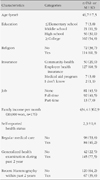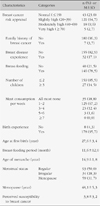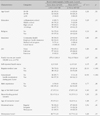Abstract
Purpose
This study was done to examine differences in mammography screening according to breast cancer and social network characteristic.
Methods
Data were collected from 187 married women 35 years and older who were using public health centers, health promotion centers, cultural centers, obstetrics and gynecology hospitals or other relevant community sites. Data were collected between October 24 and December 4, 2008. Data were analyzed using the SPSS/WIN 15.0 program.
Results
The participation rate for mammography screening was 35.3%. The following general and breast cancer characteristics showed statistically significant differences: religion, family incomes, regular medical-care, general health examinations during past 2 years, and history of breast disease. The following social network characteristics showed statistically significant differences: social norms and subjective norms. Using logistic regression analysis, regular medical-care, breast cancer risk appraisal, social norm, and subjective norms were highly predictive of subsequent mammography.
Conclusion
The results of this study indicate that it is important to develop and provide tailored intervention programs through integrated socially mediated programs. By consciously including social network and support systems, breast cancer detection efforts would not end as a one-time event, but naturally build on network structure of adults women, thus facilitating regular mammography screening.
Figures and Tables
References
1. Ajzen I., Fishbein M. Understanding attitudes and predicting social behavior. 1980. Englewood Cliffs: Prentice-Hall.
2. Allen J.D., Stoddard A.M., Sorensen G. Do social network characteristics predict mammography screening Practices? Health Education and Behavior. 2008. 35(6):763–776.
3. Breast cancer facts and figures 2007~2008. American Cancer Society. 2008. Retrieved May 16, 2011. from: http://www.cancer.org.
4. Champion V.L., Monahan P.O., Springston J.K., Russell K., Zollinger T.W., Saywell R.M., et al. Measuring mammography and breast cancer beliefs in African American women. Journal of Health Psychology. 2008. 13(6):827–837.
5. Chang Y.E. The analysis of the association factors which influence on the breast and cervix cancer screening in Korean women: Based on the 2005 Korean national examination health and nutrition survey. 2010. Seoul: Korea University;Unpublished master's thesis.
6. Cohen J. Statistical power analysis for the behavior science. 1988. 2 edition. Lawrence Erlbaum.
7. Cohen M. Breast cancer early detection, health beliefs, and cancer worries in randomly selected women with and without a family history of breast cancer. Psycho-oncology. 2006. 15(10):873–883.
8. Curbow B., Bowie J., Garza M.A., McDonnell K., Scott L.B., Coyne C.A., et al. Community-based cancer screening programs in older populations: making progressbut can we do better? Preventive Medicine. 2004. 38(6):676–693.
9. Davis D.T., Bustamante A., Brown C.P., Wolde-Tsadik G., Savage E.W., Cheng X., et al. The urban church and cancer control: A source of social influence in minority communities. Public Health Reports. 1994. 109(4):500–506.
10. Han G.H., Kim J.H., Kim K.M. Supportive and conflictual social networks and mental health of the middle-aged in Korea: Does it vary by gender? Journal of the Korea Gerontological Society. 2003. 23(2):155–170.
11. Ham O.K. Analysis of factors related to mammography screening behavior women: Use of health belief model. Journal of Korea Community Health Nursing Academic Society. 2004. 18(1):187–194.
12. Hur H.K., Park S.M., Kim G.Y. Factors related to the stage of mammography screening in married Korean women. Korean Journal of Adult Nursing. 2004. 16(1):72–81.
13. Hwang R.I. A study on the influential factors in mammography screening practive amomg low-income women. 2004. Seoul: Korea University;Unpublished doctoral dissertation.
14. 2006~2008 Breast cancer facts & figures. Korean Breast Cancer Society. 2008. From the Korean Breast Cancer Society Web site: http://www.kbcs.or.kr.
15. Kim T.K. Development of a prediction model of the intention of mammography in women. 2008. Seoul: Hanyang University;Unpublished doctoral dissertation.
16. Kim Y.B. Analysis on cognitive and behavioral factors associated with the stage of change on breast cancer screening behavior among women in a community. Journal of Korean Society for Health Education and Promotion. 2006. 23(2):77–89.
17. Health insurance forum: 2008 Spring. National Health Insurance Corporation. 2008. from the National Health Insurance Corporation Web site: http://www.nhic.or.kr.
18. Statistical yearbook of the cause of death. Statistics Korea. 2008. From the Statistics Korea Web site: http://www.kostat.go.kr.
19. Lechner L., de Vries H., Offermans N. Participation in a breast screening program: influence of past behavior and determinants on future screening participation. Preventive Medicine. 1997. 26(4):473–482.
20. Lee C.H., Roh J.W. Current opinion for breast cancer screeing. Korean Journal of Obstetrics and Gynecology. 2008. 51(9):933–942.
21. Lee C.Y., Ko I.S., Kim H.S., Lee W.H., Chang S.B., Min J.S., et al. Development and validation study of the breast cancer risk appraisal for Korean women. Nursing and Health Sciences. 2004. 6(3):201–207.
22. Lewin S.A., Dick J., Pond P., Zwarenstein M., Aja G., van Wyk B., et al. Lay health workers in primary and community health care. Cochrane Review. 2005. (1):CD004015.
23. Lin N., Simeoper R., Ensel W.M., Kuo W. Social support, stressful life events and illness: A model and an empirical test. Journal of Health and Social Behavior. 1979. 20(2):108–119.
24. Marshall G. A dictionary of sociology. 1998. Oxford, UK: Oxford University Press.
25. Mitchell J.C. Mitchell J.C, editor. The concept and use of social networks. Social networks in urban situation: Analysis of personal relationships in Central African towns. 1969. England: Manchester University Press.
26. Padula C.A., Sullivan M. Long-term married couple's health promotion behaviors: identifying factors that impact decision-making. Journal of Gerontological Nursing. 2006. 32(10):37–47.
27. Russell K.M., Perkins S.M., Zollinger T.W., Champion V.L. Sociocultural context of mammography screening use. Oncology Nursing Forum. 2006. 33(1):105–112.
28. Surra K.A.. Milardo R.M, editor. The influence of the interactive network on developing relations. Families and Social Networks. 1988. Beverly Hills CA: Sage.
29. Wellman B.. Marsden P., LIn N, editors. Studying personal communities. Social structure and network analysis. 1982. Beberly Hills, CA: Sage.
30. Youm Y.S. Social network effects on breast cancer patient (Grant#5 P50CA106743). 2003. Chicago, IL: University of Illinois at Chicago, Center for Public Health and Health Disparities.




 ePub
ePub Citation
Citation Print
Print









 XML Download
XML Download